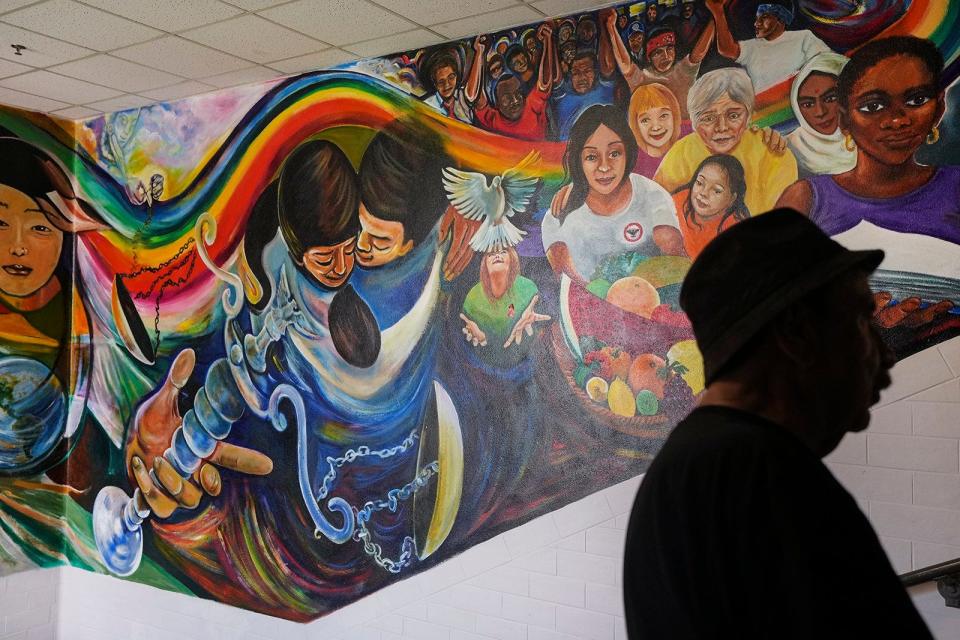Opinion: Planned UT demolition would erase history and art
We call upon our community to object to the imminent demolition of the culturally significant UT Steve Hicks Social Work building (SHSSW), formally the University Junior High (UJH), with its Raul Valdez mural and tree canopy.
As one of only four UT Austin buildings on the National Register of Historic Places, this building holds immense cultural significance. It began as a partnership between UT and Austin Public Schools (AISD) in 1933, as a laboratory school to educate children and train teachers in innovative educational theory and practices. Paul Philippe Cret, a renowned architect, designed the Spanish Revival building which was significant in the subsequent design of the UT campus.
Although segregated for its first two decades, it was considered a model junior high school from its inception at the height of the Depression. In 1957, University Junior High was the first integrated by choice junior high in Austin, a full decade before the rest of AISD. The school was unique for its excellence in education and the harmonious interaction of its distinct racial and ethnic groups. A multitude of teachers were trained through this collaboration with UT’s Department of Education.

UJH closed as a public school in 1967, with various uses by UT until it was renovated as the School of Social Work in 1993. From 1993 to 2011, the school was led by Barbara White, the first African American Dean at the University of Texas, a national leader in the profession and Social Work Pioneer.
In 1995, Dean White commissioned distinguished artist Raul Valdez to create a mural in the grand staircase. “Heart and Soul” depicts scenes of social ills, injustice, resiliency, hope and social justice. It has provided inspiration for generations of social work students, scholars and visitors. This masterpiece is unique among all the art on the UT campus. In 2001, the building entered the National Register of Historic Places.
The building’s grounds host myriad trees, including heritage oaks of incalculable value. UT’s plan is to raze the building, trees, and flatten the site to create a football practice field. To the east, the Moody Center, cooling plant, and maintenance facilities create impervious cover. If UT’s plan is pursued, runoff from this will flow into Waller Creek, potentially creating environmental damage. Thus far, there is no plan for an environmental impact study.
These actions would result in environmental impact due to waste from debris and carbon emissions from new construction materials and transportation. By repurposing the structure, UT can model sustainable development practices that align with its current sustainability initiatives.
The university has a history of erasure of its uncomfortable past. In 1967, the University applied for and received urban renewal monies to expand research facilities east of Waller Creek. Instead, UT expanded athletic facilities and displaced 350 families and small businesses. UJH was closed that same year. Soon thereafter, in 1969, UT expanded the stadium by destroying heritage oaks and the riparian zone along Waller Creek. Will UT once again destroy?
Our hope is that UT’s decision for athletic expansion will be reconsidered. The UT Athletic Department’s current plan will destroy this symbol of educational innovation and the history of both segregation and early and harmonious integration in a public school.
It will destroy the Valdez mural, a significant landmark of social justice on the UT campus. It will destroy a serene and valuable tree canopy and green oasis on the increasingly urban campus. The present Denius Field can be repurposed with real grass to appease the desires of the coach and athletic director.
UT can act now to preserve and protect, pursuing renovations like those under way with the Tower, the Memorial Museum and Hogg Auditorium. UT’s leadership can be transformative, by “preserving the past to save the fUTure.” As a community, we must demand it.
Anderson and Armenta are Emeritus Clinical Professors with the Steve Hicks School of Social Work at the University of Texas.
This article originally appeared on Austin American-Statesman: Opinion: UT should preserve the past and stop planned demolition of building and art

